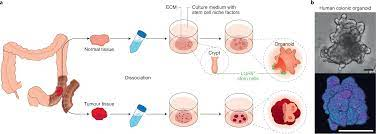
Human derived organoids
Organoids constitute an improved model system in which cell types more closely resemble the in vivo situation and are in similar conditions to those found in the human body. Diverse organoid systems provide a useful variety for their complexity and modelling capability, ranging from simple structures derived from stem cells to more complex cultures generated from multiple germ layers of developing cells via multiple differentiation protocols (1).
Therefore, it is expected that the variety of organoid models available, coupled with technological advances, will provide a series of powerful and efficient platforms for studying human development and diseases (2).
Generating organoids
Human derived organoids are generated by guided differentiation protocols that mimic developmental processes, identified through both in vivo and in vitro experiments. Human development is very limited and specific, most studies have aimed at producing organoids with properties like those of human tissues. The generation of organoids could mimic the entire process of organ development starting from pluripotent stem cells. However, it is very challenging to provide all biochemical cues that drive the differentiation and three-dimensional assembly of cells during development (2,3).
Brain organoid formation
In case of brain organoids, human pluripotent stem cells are initially guided to differentiate into embryoid bodies before further differentiation towards the destinated cell lineage. Once cell aggregates contain the developmental precursors for brain tissue patterning, the rest of developmental steps occur spontaneously in a spinning bioreactor. Media formulation plays a crucial role as it allows proper differentiation of the desired cell types from which the organoids will develop. Finally, cultures are grown in a way that allows their expansion in three dimensions, which is achieved either by aggregating cells into 3D structures or by embedding cultures into a 3D matrix (4,5).
References :
1. Hu, H. et al. Long-term expansion of functional mouse and human hepatocytes as 3D organoids. Cell 175, 1591–1606 (2018).
2. Sachs, N. et al. Long-term expanding human airway organoids for disease modeling. EMBO J. 38, e100300 (2019).
3. Osakada, F., Ikeda, H., Sasai, Y. & Takahashi, M. Stepwise differentiation of pluripotent stem cells into retinal cells. Nat. Protoc. 4, 811–824 (2009).
4. Lancaster, M. A. et al. Guided self-organization and cortical plate formation in human brain organoids. Nat. Biotechnol. 35, 659–666 (2017).
5. Lancaster, M. A. et al. Cerebral organoids model human brain development and microcephaly. Nature 501, 373–379 (2013). Lancaster et al. report that the complexity of human brain development can be modelled by human PSC-derived organoids.



